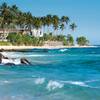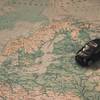כללי
 מהו הזמן הטוב ביותר לבקר בסרי לנקה?
מהו הזמן הטוב ביותר לבקר בסרי לנקה?
 What is the climate like in Sri Lanka?
What is the climate like in Sri Lanka?
 How do I access internet in Sri Lanka?
How do I access internet in Sri Lanka?
 מה לא לעשות בסרי לנקה?
מה לא לעשות בסרי לנקה?
 לאן כדאי ללכת בסרי לנקה למשך שבוע?
לאן כדאי ללכת בסרי לנקה למשך שבוע?
 Where should I go in Sri Lanka for 2 weeks?
Where should I go in Sri Lanka for 2 weeks?
 איזה סוג של מתאם אני צריך עבור השקעים?
איזה סוג של מתאם אני צריך עבור השקעים?
תחבורה
אנשים
אירוח
אוכל ושתייה
ביקור באתרים
משפטי
כסף
בטיחות ובריאות
נסיעות משפחתיות

What should I pack for my trip?
Sri Lanka is one of the most underrated travel locations in the world providing endless adventures around every corner that you have to see to believe. If you are wondering what to pack for Sri Lanka but not sure where to start this list will help prepare you for what you can expect.
Rain jacket and umbrella. There are various dry and wet seasons around the island, so rain is never too far away in Sri Lanka. Always search for comfortable travel materials that can be easily packed. The best are rain jackets come with zip slits under the arms so they get you some ventilation while keeping you dry.
Mosquito repellent and sunscreen. You can get both in Sri Lanka, but to avoid high prices and losing your travel time to go shopping, it is better to bring these from home. This way you have some repellent right when you land (these aren’t “just in case” items, but don’t worry, malaria is not an issue in Sri Lanka).
Sandals or jelly flats. You have to take your shoes off frequently in Sri Lanka – not just for entering temples, but sometimes also to go into cafés, restaurants, shops, or massage parlors. Breathable, open shoes are just perfect for that. Hiking sandals are a good option. There is also always the possibility to buy a pair of plastic jelly flats. They cost 3–5 USD per pair, are waterproof, comfortable, easy to slip on and off. Comfy flip-flops sort of work, but will slip around in the rain. Always choose shoes that can dry quickly.
Sarong. You should definitely bring a sarong or a large, versatile scarf to Sri Lanka because they have so many uses for travelers: towel, blanket, swimsuit cover-up, curtain, skirt, beach towel, and scarf – the list goes on. Remember that sarongs might not be an absolutely ideal replacement for all of those items, but they work great in a pinch. Plus they’re lightweight, and they dry quickly. When choosing the right sarong or scarf, opt for white or light colors as much as possible; in some places like Anuradhapura, you won’t be allowed to enter temples wearing black.
Warm weather clothes. Wondering what to wear in Sri Lanka? Regardless of the time of year, be prepared for hot and humid temperatures. A good wardrobe to travel within Sri Lanka would include:
- 3–4 t-shirts or tank tops (better to avoid spaghetti straps);
- 2–3 pairs of longish shorts or loose pants;
- 2 skirts + 1 dress.
Remember to bring some clothes that cover the knees and shoulders. You can’t swing a string of prayer beads in Sri Lanka without hitting some kind of temple or religious site, and they all require modest clothing.
Colder weather clothes. You’ll also need something warmer for the plane ride and chilly AC on busses. Furthermore, in the mountains of Nuwara Eliya, temperatures have been known to drop to as low as 10° C at night during winter (December–February).
Backpack and a daypack. It’s best to take two backpacks with you to Sri Lanka: a decent sized backpack where you’ll pack all of your clothes and other items, and a smaller daypack for all of your valuables. Your main backpack can be checked in on flights and put in the luggage compartment on buses. However, your daypack, containing your passport, phone, money, and all other important items should be kept on your person at all time. Plus, you can use it for smaller day trips as well. If you have dropped off your luggage at the hotel or hostel, there is nothing easier than to just go out with few valuables.
Hiking shoes. A trip to Sri Lanka is easily doable in just sandals. However, if you plan on doing any serious hiking while you’re there, or you’re a runner, you’re going to need something more than sandals. You’ll need a filled-in shoe that you can wear with sports socks. If you are buying new ones just for this trip, keep in mind to wear them beforehand at least a couple of times.
Bathing suit and quick dry towel. Between the beaches and swimming holes, you’ll have plenty of opportunities to go swimming, so definitely bring your bathing suit. You might also bring a quick-dry towel. In addition to being your beach blanket and emergency towel, you can also use it as a scarf, beach cover-up, extra layer in more conservative areas or an imprompt bag for your dirty laundry. It is also great to have hand sanitizer and wet tissues with you. You never know when you will need to wash your hands, for example during train trips there may not be running water to wash your hands. Dry shampoo is great to bring too.
Travel essentials. Of course, make sure you haven’t forgotten to pack your passport, driver’s license (only if you are planning to drive), insurance card and a good book. Also include a good old-fashioned paper notebook, pen and printed itinerary with addresses and phone numbers of all of your hotels. Bring a file or passport holder so that your travel documents won’t suffer from the humidity. If you can manage to have your hotel names translated into Sinhala or Tamil, it could save you time finding them; not every taxi and tuk-tuk driver can read English. Most appreciated having the information on a piece of paper they could look at and almost all of them preferred to call the hotel and get verbal directions in their own language.
Camera, memory cards and spare batteries. Sri Lanka is ridiculously photogenic. You’ll have a tough time finding decent photography supplies anywhere there, so bring more than you think you’ll need. If you’re looking for something that’s going to take amazing photos without you needing to be a professional photographer, go with a mirrorless camera, combining the advantages of DSLR and compact camera.
Waterproof phone cover. Whether you’re out in the rain or tip-toeing behind the enormous waterfalls of Sri Lanka, it’s a wise investment to get yourself a waterproof phone cover.
Power bank. Sri Lanka can be a crazy place to get around and as a result, you’ll spend a lot of time looking at maps trying to work out the best route to your next destination. A few hours on Google Maps is a sure way to drain your phone battery, alas, a power bank is a necessity.
Power adaptor. Charging all your gear can be difficult enough in Sri Lanka, it pays to get yourself a good quality adapter that will plug into any wall without fail. If you get yourself a worldwide adapter, it will come in handy for the rest of your travels too. There’s nothing worse than traveling around Asia and having to buy a new adaptor for every single country. Get a universal adaptor and simplify your travels.

איזה סוג של מתאם אני צריך עבור השקעים?

אילו משקאות אלכוהוליים לנסות במהלך השהות בסרי לנקה?

איפה ניתן לקנות אלכוהול בסרי לנקה ובכמה עולה?

מהם ההגבלות הקשורות לצריכת אלכוהול?

איזה אוכל יכולים הילדים לאכול בסרי לנקה?
